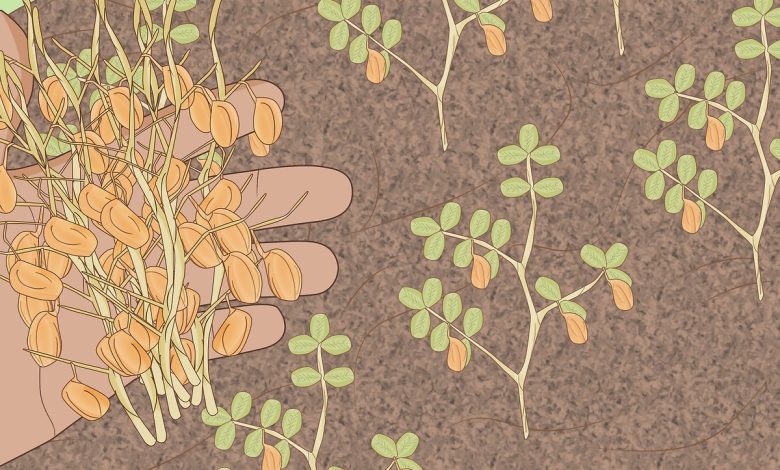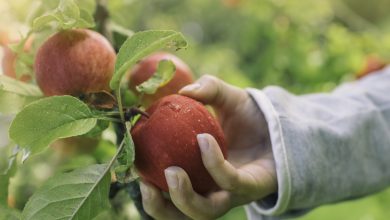How to Plant Lentils in [8 Steps]: Full Text and Images

Did you knowthe use of lentils is ancient?
In fact, it is considered that ancient Babylon was able to consolidate itself thanks to the social stabilization that lentils brought.
Or… What the Latin word to designate the lentil is lens, which derives from the word lens and ends up being used to designate the curved crystals that make up the glasses?
Important points for Sowing Lentils:
- When? at the end of autumn to take advantage of the rainy season.

- Where? It is a winter crop, and adapts very well to cool climates. It requires a lot of sunlight.
- Harvest time? Several months. In late spring or summer.
- How do we prepare the land? It requires deep, fresh soils, rich in organic matter and loose.
- How do we water? Ideal, with drip. It is not very demanding, but requires moist soil. We will avoid flooding.
- How do we sow? Here step by step.
- How do we harvest? When the plants have reached 60 cm in height and the pods have a yellow color similar to the color of wheat.
- Favorable associations? Carrots, melon, corn, rice, cucumbers, watermelon, cauliflower, broccoli, parsley, and cumin.
- Unfavorable associations? Soy, sunflower, beet and potato.
- Plagues and diseases? Aphids, weevils and fungi.
Lentils are herbaceous plants with great nutritional properties, especially due to their high protein content.
Thanks to this and to the ease of its cultivation, its production is increasing throughout the world.
learn howplant lentils easilyand take advantage of its great benefits.
What do we need to grow lentils?
When? The dates
We want to plant lentilsin late autumnto take advantage of the rainy season.
Where? The temperature and the light
It is a winter crop, and it adapts very well to cool climates.
The ideal temperature for its development is between 6 and 28 ºC constant.
For its germination it needs a temperature of 15 to 21ºC.
It is quite sensitive to frost.
It requires a good amount of sunlight.
Although you have to protect the smaller shoots with padding so they don’t burn.
If you plant lentils in a region with very intense sun, you have to reduce the exposure.
How do we water? Humidity
It is highly tolerant to drought, but does best in moist, well – drained soils.
Ideally requires annual rainfall of 260 to 850 mm.
As it is not very demanding to water, the excess can end up rotting the roots.
It is advisable to reduce the risks during the winter.
The ideal irrigation option is usually drip irrigation.
How do we prepare the land? nutrients and substrate
The substrate must have a good drainage, which allows the retention of humidity but eliminates the excess.
It requires deep, fresh soils, rich in organic matter and loose.
Preferably, rich in phosphorus and sandy.
 It’s advisablethe use of an organic fertilizer to make the soil spongy.
It’s advisablethe use of an organic fertilizer to make the soil spongy.
It is intolerant to poorly drained soils that are easily waterlogged. The deep, stony soils facilitate the infiltration of water into the soil.
The optimal pH ranges between 5.5 and 9.0
It is a crop very sensitive to salinity.
How to plant lentils step by step
1) Clear the ground
It removes weeds and remains of previous crops and all kinds of residues to ensure that the lentils receive the correct amount of nutrients.
2) Moisten the soil before planting lentils
This reduces the risk of expelling the seeds by the force of the water.
3) Fertilize the soil
Spread some humus on the soil to improve the overall quality before you start sowing seeds.
4) Introduce the seeds 5 cm deep
Very small seeds should be sown shallower. Cover them lightly.
Remember to keep a separation distance of between 10 and 15 centimeters between each plant.
5) Water as soon as you see that the soil is dry
To find out when it is convenient to water, bury a pencil in the soil. If it comes out dry it means that the soil needs to be watered.
On the contrary, if it comes out with traces of soil attached, it means that the soil still contains enough moisture in the lower layers.
Wait until the top 2 inches of soil has dried out before watering it again.
6) Fertilize regularly
The organic fertilizer improves the physical properties of the soil, giving it a spongy texture and an amount of organic matter that is effective for the development of plants.
The phosphoric fertilizer facilitates the growth and development of the roots, allowing them to reach deep areas to extract water.
7) Prepare a trellis or structure to support the plant
Fully grown lentils can grow to more than 70 cm tall.
If they fall, their flowers and pods may break off or touch the ground.
8) Check your plants regularly to avoid pests and diseases.
Started spring it is very important to fumigate the plant with some homemade insecticide to avoid pests.
harvest and gathering
Harvest: In late spring or summer.
The lentil is harvested at the end of June or beginning of July, when the plants have reached 60 cm in height and the pods have a yellow color similar to the color of wheat.
To harvest the lentil, all you have to do is cut the pods, place them on a tarp and step on them carefully to break them.
Then, remove the lentils and store them in a dry and cool place for consumption.
You can store them in an airtight container until you want to use them.
Favorable associations of lentils
They pair well with carrots and melon.
Other good combinations are: corn, rice, cucumbers, watermelons, cauliflower, broccoli, parsley and cumin.
They do not associate very well with soybeans, sunflowers, beets and potatoes, since they promote the appearance of pests and diseases.
Common pests and diseases
aphids
The aphid that most attacks the lentil crop is Aphys craccivora or black aphid. It settles in the leaves and stems where it causes damage because it extracts the sap from the plant.
The most characteristic symptom of its presence is the appearance of dry areas on the plant that progress until it is completely covered.
The aphid can endanger the crop in a very short time.
To combat them, potassium soap can be applied to the underside of the plants.
If the plague persists or is very abundant, after cleaning the leaves with soap, we will apply neem extract, which will act as an insecticide.
weevils
There are two species that most affect lentil cultivation: Bruchus lentis and Bruchus sinaticornis.
They attack the seed, since the larvae carry out their biological cycle within it.
To prevent them from appearing, it is recommended to apply insecticides when the pods begin to set.
Mushrooms
The main fungi that affect the sowing of lentils are:
Fusarum oxysporum and Fusarium sp. Lentis: both produce wilting and cause the plant to die.
To prevent it, it is recommended:
- crop rotation.
- Apply horsetail.
- Ventilate the crop and avoid waterlogging.
- Sow lentils by drip.
- Avoid planting too deep.
Ascochyta fabae: is another type of fungus that causes considerable damage to the crop and manifests itself in leaves, stems and seeds.
Dark, circular spots appear on the leaves on the edges, which end up causing them to fall.
Symptoms on the seed begin with wrinkled skin, dark spots, and finally the appearance of the whitish mycelium of the fungus.
To prevent its appearance, it is recommended, before sowing, to spray the seeds with a healthy mixture of bacteria to inoculate them.
A general-purpose inoculant for peas and beans can be found at garden specialty stores.


![Photo of Sow Alfalfa: [Substrate, Irrigation, Images + Step by Step]](https://www.complete-gardening.com/wp-content/uploads/2022/08/sow-alfalfa-substrate-irrigation-images-step-by-step-390x220.jpg)
![Photo of Pests and Diseases of Weeping Willow: [Detection, Causes and Solutions]](https://www.complete-gardening.com/wp-content/uploads/2021/06/sauce_lloron_1603640600-390x220.jpg)
![Photo of Carnation Cuttings in Water: [Concept, Time, Rooting and Sowing]](https://www.complete-gardening.com/wp-content/uploads/2021/06/Que-significa-plantar-por-esquejes-6-390x220.jpg)